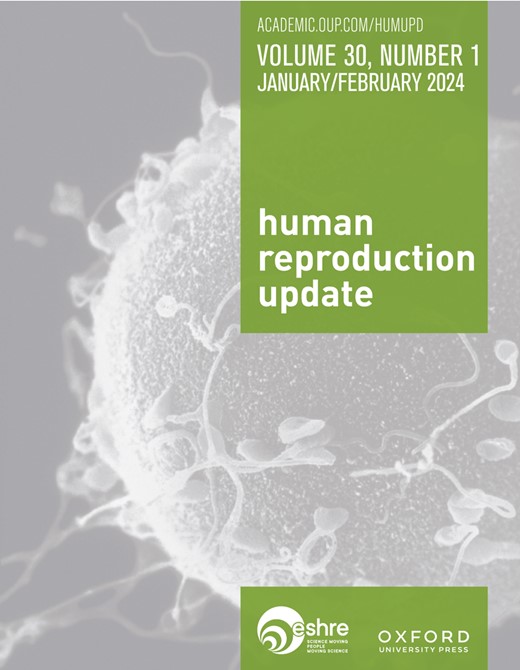Meiotic recombination: insights into its mechanisms and its role in human reproduction with a special focus on non-obstructive azoospermia.
IF 14.8
1区 医学
Q1 OBSTETRICS & GYNECOLOGY
引用次数: 16
Abstract
BACKGROUND Meiosis is an essential stage in the life cycle of sexually reproducing species, underlying formation of haploid gametes and serving as the basis of genetic diversity. A central mechanism of meiosis is recombination between homologous chromosomes, during which programmed DNA double-strand breaks (DSBs) are sequentially repaired to form the crossovers essential for faithful chromosomal segregation. Aberrant meiotic recombination often leads to gametogenic failure or produces aneuploid gametes resulting in subfertility or infertility, miscarriage or birth defects. OBJECTIVE AND RATIONALE The goal of this review was to characterize the molecular mechanisms of meiotic recombination and related human infertility disorders, particularly male infertility caused by non-obstructive azoospermia (NOA). SEARCH METHODS Our search included PubMed database articles, focusing mainly on English-language publications dated between January 2016 and February 2022. The search term 'meiosis' was combined with the following keywords: meiotic initiation, chromosome pairing, homologous recombination, chromosome axis, DSB, DSB repair, crossover, meiotic sex chromosome inactivation, meiotic checkpoints, meiotic arrest, NOA, premature ovarian insufficiency (POI) or premature ovarian failure, treatment and cancer. In addition, references within these articles were used to identify additional studies. OUTCOMES The preliminary search generated ∼3500 records. The majority of articles were identified as meeting abstracts or duplicates, contained non-English text or provided insufficient data and were therefore eliminated. A total of 271 articles associated with meiotic recombination were included in the final analysis. This review provides an overview of molecules and mechanisms involved in meiotic recombination processes, specifically meiosis-specific chromosome structures, DSB formation, homology search, formation of recombination intermediates and crossover formation. The cumulative results suggest that meiosis is regulated sequentially by a series of meiotic recombination genes and proteins. Importantly, mutations in these genes often affect meiotic progression, activating meiotic checkpoints, causing germ cell arrest and leading to subfertility or infertility. At least 26 meiotic recombination-related genes have been reported to be mutated in NOA in men, and 10 of these genes are mutated in POI in women. This suggests that variants of meiotic recombination-related genes can cause human subfertility or infertility, especially NOA. WIDER IMPLICATIONS Understanding the processes of homologous chromosome pairing, recombination and timely resolution of homologous chromosomes may provide guidance for the analysis of potential monogenetic causes of human subfertility or infertility and the development of personalized treatments. In clinical practice, we can develop a meiotic recombination-related gene panel to screen for gene mutations in individuals with subfertility or infertility. Testicular sperm extraction should not be recommended when an NOA-affected individual carries definite disease-causing mutations of a meiotic gene, so as to avoid the unnecessary invasive diagnosis. Risk of ovarian dysfunction should be evaluated if a woman carries meiotic recombination-related gene mutations. It may be possible to improve or restore fertility through manipulation of meiotic recombination-related genes in the future.减数分裂重组:深入了解其机制及其在人类生殖中的作用,特别关注非梗阻性无精子症。
背景减数分裂是有性繁殖物种生命周期中的一个重要阶段,是单倍体配子形成的基础,也是遗传多样性的基础。减数分裂的一个核心机制是同源染色体之间的重组,在重组过程中,程序性DNA双链断裂(DSBs)被顺序修复,形成对忠实的染色体分离至关重要的交叉。异常减数分裂重组通常会导致配子发生失败或产生非整倍体配子,导致不育、流产或出生缺陷。目的和理由本综述的目的是描述减数分裂重组和相关人类不育障碍的分子机制,特别是非梗阻性无精子症(NOA)引起的男性不育。检索方法包括PubMed数据库文章,主要关注2016年1月至2022年2月之间的英文出版物。搜索术语“减数分裂”与以下关键词组合:减数分裂起始、染色体配对、同源重组、染色体轴、DSB、DSB修复、交叉、减数分裂性染色体失活、减数分裂检查点、减数分裂阻滞、NOA、卵巢早衰(POI)或卵巢早衰、治疗和癌症。此外,这些文章中的参考文献用于确定其他研究。结果初步搜索生成了~3500条记录。大多数文章被认定为会议摘要或副本,包含非英文文本或提供的数据不足,因此被删除。共有271篇与减数分裂重组相关的文章被纳入最终分析。本文综述了减数分裂重组过程中涉及的分子和机制,特别是减数分裂特异性染色体结构、DSB形成、同源性搜索、重组中间体的形成和交叉形成。累积结果表明,减数分裂是由一系列减数分裂重组基因和蛋白质顺序调节的。重要的是,这些基因的突变通常会影响减数分裂进程,激活减数分裂检查点,导致生殖细胞停滞,并导致低生育能力或不孕。据报道,至少有26个减数分裂重组相关基因在男性的NOA中发生突变,其中10个基因在女性的POI中发生突变。这表明减数分裂重组相关基因的变体可能导致人类生育能力低下或不孕,尤其是NOA.WIDER IMPLICATION了解同源染色体配对的过程,同源染色体的重组和及时解析可能为分析人类低生育能力或不孕的潜在单基因原因和开发个性化治疗方法提供指导。在临床实践中,我们可以开发一个减数分裂重组相关基因小组,以筛查低生育能力或不孕患者的基因突变。当NOA患者携带明确的减数分裂基因致病突变时,不建议提取睾丸精子,以避免不必要的侵入性诊断。如果女性携带减数分裂重组相关基因突变,应评估卵巢功能障碍的风险。未来可能通过操纵减数分裂重组相关基因来提高或恢复生育能力。
本文章由计算机程序翻译,如有差异,请以英文原文为准。
求助全文
约1分钟内获得全文
求助全文
来源期刊

Human Reproduction Update
医学-妇产科学
CiteScore
28.80
自引率
1.50%
发文量
38
期刊介绍:
Human Reproduction Update is the leading journal in its field, boasting a Journal Impact FactorTM of 13.3 and ranked first in Obstetrics & Gynecology and Reproductive Biology (Source: Journal Citation ReportsTM from Clarivate, 2023). It specializes in publishing comprehensive and systematic review articles covering various aspects of human reproductive physiology and medicine.
The journal prioritizes basic, transitional, and clinical topics related to reproduction, encompassing areas such as andrology, embryology, infertility, gynaecology, pregnancy, reproductive endocrinology, reproductive epidemiology, reproductive genetics, reproductive immunology, and reproductive oncology. Human Reproduction Update is published on behalf of the European Society of Human Reproduction and Embryology (ESHRE), maintaining the highest scientific and editorial standards.
 求助内容:
求助内容: 应助结果提醒方式:
应助结果提醒方式:


